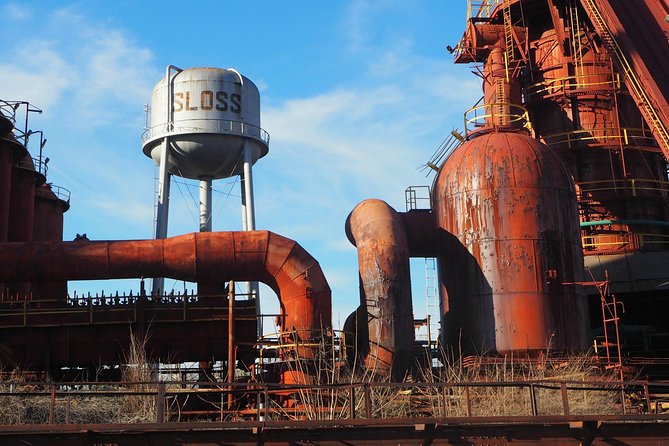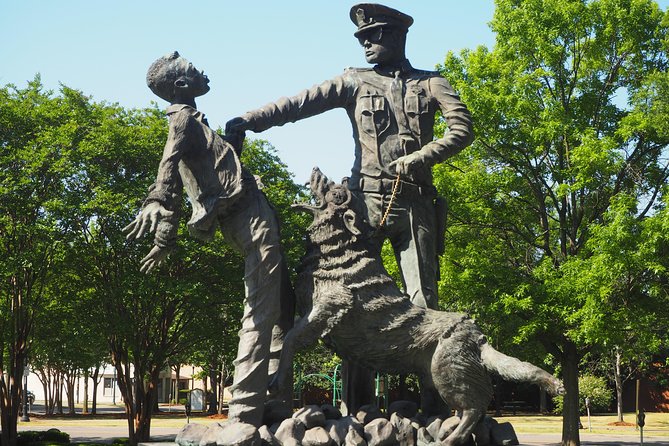Historical Highlights of Birmingham
Symbolizing a tapestry of resilience and progress, Birmingham’s historical highlights beckon curious minds to uncover the layers of its past.
From the echoes of the Industrial Revolution to the reverberations of the Civil Rights Movement, the city’s narrative is a mosaic of triumphs and challenges that have sculpted its character.
As visitors traverse through time, they will encounter a city that not only embraces its storied past but also forges ahead with a vibrant cultural tapestry that resonates with the soul of America.
Key Points

- Birmingham’s rapid industrial growth in the late 19th century shaped its economy and urban landscape.
- The city played a pivotal role in the Civil Rights Movement, achieving significant social progress.
- The steel industry was crucial to Birmingham’s development, influencing its economy and reputation.
- Birmingham’s cultural diversity and heritage are celebrated through art, music, and cuisine, uniting its residents.
Here's some more nearby activities we've reviewed
Birmingham’s Founding and Growth
In 1871, Birmingham was founded and rapidly grew into a major industrial center in the late 19th century. Its impact on the economy was profound, transforming the region into a hub of manufacturing and trade.
The urban development of Birmingham during this period was remarkable, with the city rapidly expanding to accommodate the influx of workers and businesses. The growth of industries such as steel production and mining fueled the economy, attracting a diverse population seeking employment opportunities.
As Birmingham flourished, new infrastructure, including railroads and commercial buildings, sprang up, shaping the city’s landscape. This period of rapid urbanization laid the foundation for Birmingham’s future prosperity and solidified its reputation as a prominent industrial powerhouse in the United States.
Industrial Revolution Impact
The Industrial Revolution reshaped Birmingham’s landscape, propelling it into a new era of economic growth and technological advancement. This transformation had a profound impact on society, revolutionizing the way people lived and worked. Here are three key aspects of the Industrial Revolution’s impact on Birmingham:
-
Rapid Urbanization: Birmingham saw a surge in population as people flocked to the city in search of employment in the burgeoning industries.
-
Technological Advancements: Innovations like the Bessemer process revolutionized steel production, propelling Birmingham to become a leading steel producer.
-
Social Changes: The Industrial Revolution brought about shifts in social structure, creating new classes of workers and reshaping traditional societal norms.
This period marked a significant turning point in Birmingham’s history, laying the foundation for its future industrial prowess.
Civil Rights Movement Influence

With its pivotal role in the Civil Rights Movement, Birmingham stands as a beacon of courage and resilience in the fight for equality and justice. The city’s impactful activism during this period brought about significant social progress, with notable figures like Martin Luther King Jr. leading marches and protests to challenge segregation and discrimination.
Birmingham’s streets witnessed pivotal moments, such as the Birmingham Campaign of 1963, which drew national attention to the harsh realities faced by African Americans. The city’s Civil Rights landmarks, including the 16th Street Baptist Church and the Civil Rights Institute, serve as reminders of the sacrifices made and progress achieved.
Birmingham’s legacy in the Civil Rights Movement continues to inspire generations to advocate for justice and equality.
Steel Production Legacy
Birmingham’s steel production legacy intertwines with its historical significance, shaping the city’s industrial identity and economic growth. The steel industry played a pivotal role in Birmingham’s development, leaving a lasting impact on the city’s landscape and economy.
The manufacturing heritage of Birmingham is deeply rooted in the steel industry, with numerous factories and mills contributing to the city’s growth. The steel produced in Birmingham not only fueled local infrastructure projects but also played a crucial role in supplying materials for national and international markets.
This rich history of steel production has cemented Birmingham’s reputation as a key player in the industrial landscape of the United States.
Cultural Diversity and Heritage
Amidst the industrial echoes of its steel past, Birmingham’s cultural tapestry weaves together a vibrant mosaic of traditions and histories. The city’s cultural fusion is a testament to its diverse and multicultural population, showcasing a rich tapestry of ethnic traditions.
Birmingham’s commitment to historical preservation ensures that these traditions are celebrated and passed down through generations, contributing to a strong sense of community identity. From annual festivals honoring various heritages to multicultural events that bring people together, Birmingham embraces its cultural diversity with pride.
Through art, music, cuisine, and other expressions of heritage, the city continues to evolve while cherishing the roots that make it unique. This celebration of cultural heritage is a cornerstone of Birmingham’s identity and a source of unity among its residents.
Historical Landmarks and Museums
Exploring Birmingham’s historical landmarks and museums provides a captivating journey through the city’s rich past and cultural significance. Visitors can discover architectural treasures and hidden gems while learning about the preservation efforts and community engagement that safeguard these historical sites.
Some must-see attractions include:
-
Birmingham Civil Rights Institute: A pivotal landmark chronicling the city’s role in the Civil Rights Movement.
-
Sloss Furnaces National Historic Landmark: Offering insight into Birmingham’s steel production history and industrial heritage.
-
Birmingham Museum of Art: Showcasing diverse cultural exhibits and engaging the community through artistic expression.
These sites not only offer a glimpse into Birmingham’s history but also highlight the city’s commitment to preserving its heritage for future generations.
Birmingham’s Role in the Arts
What artistic influences have shaped Birmingham’s cultural landscape over the years? Birmingham’s arts scene has flourished, with diverse artistic expressions reflecting the city’s rich history and creative community. From traditional to contemporary art forms, Birmingham offers a vibrant platform for artists to showcase their talents. The city’s role in nurturing creativity and fostering artistic endeavors is evident in the various galleries, theaters, and cultural institutions that contribute to its dynamic arts scene. Whether exploring local artists’ works or attending performances by renowned musicians and dancers, Birmingham’s arts community continues to captivate residents and visitors alike. Below is a glimpse of some key aspects defining Birmingham’s role in the arts:
| Artistic Expressions | Creative Community |
|---|---|
| Local Art Exhibitions | Collaborative Projects |
| Music Concerts | Artist Residencies |
| Dance Performances | Community Workshops |
| Theater Productions | Public Art Installations |
| Cultural Festivals | Networking Events |
Here's a few more nearby tours and experiences we have reviewed.
Common questions
What Are Some Popular Local Foods or Dishes to Try in Birmingham?
When exploring Birmingham’s culinary scene, visitors can savor local delicacies like hot chicken, fried green tomatoes, and banana pudding. Food tours and cooking classes offer an immersive experience into the city’s rich culinary traditions.
Are There Any Annual Festivals or Events That Celebrate Birmingham’s History and Culture?
Birmingham hosts annual festivals celebrating its history and culture with historical reenactments, cultural parades, artisan craft demos, and storytelling sessions. These events offer engaging insights into the city’s rich heritage and diverse traditions.
What Are Some Lesser-Known Historical Sites or Hidden Gems in Birmingham Worth Visiting?
When exploring Birmingham’s historical sites, visitors can uncover hidden artifacts and forgotten stories in its historic neighborhoods. Preserved relics offer glimpses into the city’s past, making these lesser-known gems worth visiting for a unique experience.
Can Visitors Participate in Any Hands-On Experiences or Workshops Related to Birmingham’s History?
Visitors can engage in hands-on workshops and interactive experiences related to Birmingham’s history. These opportunities offer immersive learning and a deeper connection to the city’s past. Dive into Birmingham’s rich heritage through engaging activities.
How Has Birmingham’s Architecture Evolved Over Time and What Are Some Unique Architectural Landmarks to See?
Birmingham’s architecture reflects a blend of historical influences and modern adaptations. From its industrial past to urban renewal projects, visitors can explore unique landmarks like the Alabama Theatre and Sloss Furnaces, showcasing the city’s architectural diversity.
Here's more of our most recent tour reviews happening neaby
- Iconic Birmingham: A Journey Through Heart & Heritage
- The Birmingham Downtown Ghost Self-Guided Walking Tour
- Inspiring Birmingham – Family Walking Tour
- From Birmingham: Warner Bros. Studio Tour Rail Package
- Arrival Private Transfers From Airport BHX to Birmingham in Luxury Van
- Birmingham Airport Transfers: Airport BHX to Birmingham City in Luxury Car
- Photography Workshop
- Private Transfer From Birmingham to Manchester Airport (Man)
- Ghosts and Graveyards Driving Tour
- Experience Birmingham – The Historic Highlights
- Bar & Club Queue Jump Entry Party Pass to Multiple Venues in Birmingham
Last Words
To sum it up, Birmingham’s rich history and cultural significance make it a captivating destination for history buffs and cultural enthusiasts alike.
From its founding and growth to its pivotal role in the Civil Rights Movement, Birmingham’s historical highlights provide a deeper understanding of its place in American history.
With a legacy of industrial prowess, diverse heritage, and vibrant arts scene, Birmingham continues to draw visitors seeking to uncover the stories that have shaped this dynamic city.





